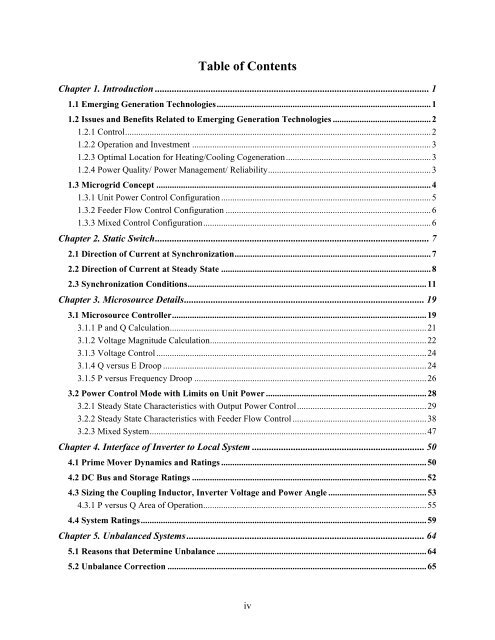Control and Design of Microgrid Components - Power Systems ...
Control and Design of Microgrid Components - Power Systems ...
Control and Design of Microgrid Components - Power Systems ...
You also want an ePaper? Increase the reach of your titles
YUMPU automatically turns print PDFs into web optimized ePapers that Google loves.
Table <strong>of</strong> Contents<br />
Chapter 1. Introduction ................................................................................................................. 1<br />
1.1 Emerging Generation Technologies................................................................................................1<br />
1.2 Issues <strong>and</strong> Benefits Related to Emerging Generation Technologies ............................................2<br />
1.2.1 <strong>Control</strong>.........................................................................................................................................2<br />
1.2.2 Operation <strong>and</strong> Investment ...........................................................................................................3<br />
1.2.3 Optimal Location for Heating/Cooling Cogeneration.................................................................3<br />
1.2.4 <strong>Power</strong> Quality/ <strong>Power</strong> Management/ Reliability.........................................................................3<br />
1.3 <strong>Microgrid</strong> Concept ...........................................................................................................................4<br />
1.3.1 Unit <strong>Power</strong> <strong>Control</strong> Configuration ..............................................................................................5<br />
1.3.2 Feeder Flow <strong>Control</strong> Configuration ............................................................................................6<br />
1.3.3 Mixed <strong>Control</strong> Configuration......................................................................................................6<br />
Chapter 2. Static Switch................................................................................................................. 7<br />
2.1 Direction <strong>of</strong> Current at Synchronization........................................................................................7<br />
2.2 Direction <strong>of</strong> Current at Steady State ..............................................................................................8<br />
2.3 Synchronization Conditions...........................................................................................................11<br />
Chapter 3. Microsource Details................................................................................................... 19<br />
3.1 Microsource <strong>Control</strong>ler..................................................................................................................19<br />
3.1.1 P <strong>and</strong> Q Calculation...................................................................................................................21<br />
3.1.2 Voltage Magnitude Calculation.................................................................................................22<br />
3.1.3 Voltage <strong>Control</strong> .........................................................................................................................24<br />
3.1.4 Q versus E Droop ......................................................................................................................24<br />
3.1.5 P versus Frequency Droop ........................................................................................................26<br />
3.2 <strong>Power</strong> <strong>Control</strong> Mode with Limits on Unit <strong>Power</strong> ........................................................................28<br />
3.2.1 Steady State Characteristics with Output <strong>Power</strong> <strong>Control</strong>..........................................................29<br />
3.2.2 Steady State Characteristics with Feeder Flow <strong>Control</strong> ............................................................38<br />
3.2.3 Mixed System............................................................................................................................47<br />
Chapter 4. Interface <strong>of</strong> Inverter to Local System ....................................................................... 50<br />
4.1 Prime Mover Dynamics <strong>and</strong> Ratings ............................................................................................50<br />
4.2 DC Bus <strong>and</strong> Storage Ratings .........................................................................................................52<br />
4.3 Sizing the Coupling Inductor, Inverter Voltage <strong>and</strong> <strong>Power</strong> Angle ............................................53<br />
4.3.1 P versus Q Area <strong>of</strong> Operation....................................................................................................55<br />
4.4 System Ratings................................................................................................................................59<br />
Chapter 5. Unbalanced <strong>Systems</strong> .................................................................................................. 64<br />
5.1 Reasons that Determine Unbalance ..............................................................................................64<br />
5.2 Unbalance Correction ....................................................................................................................65<br />
iv
















